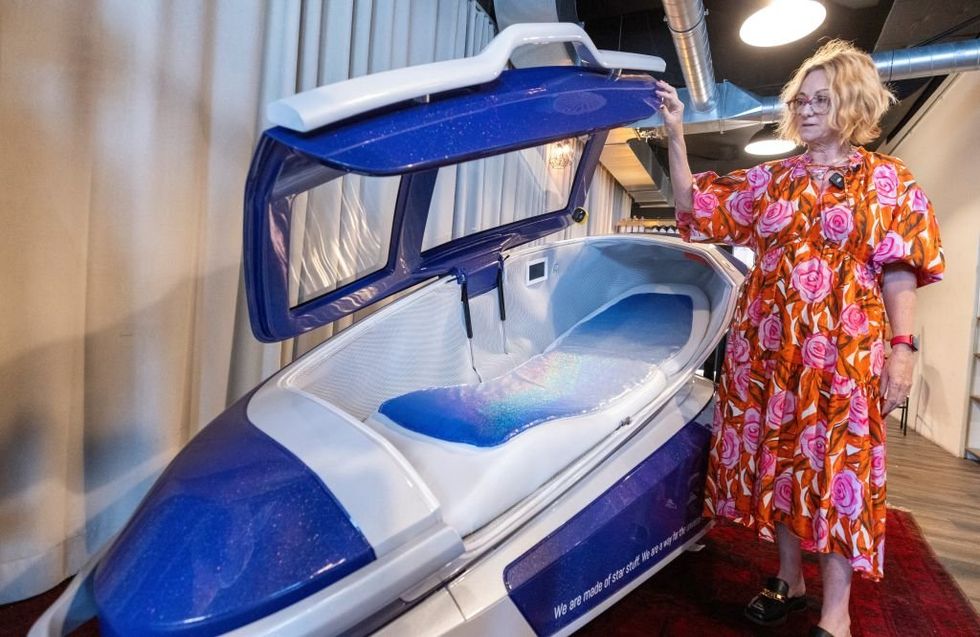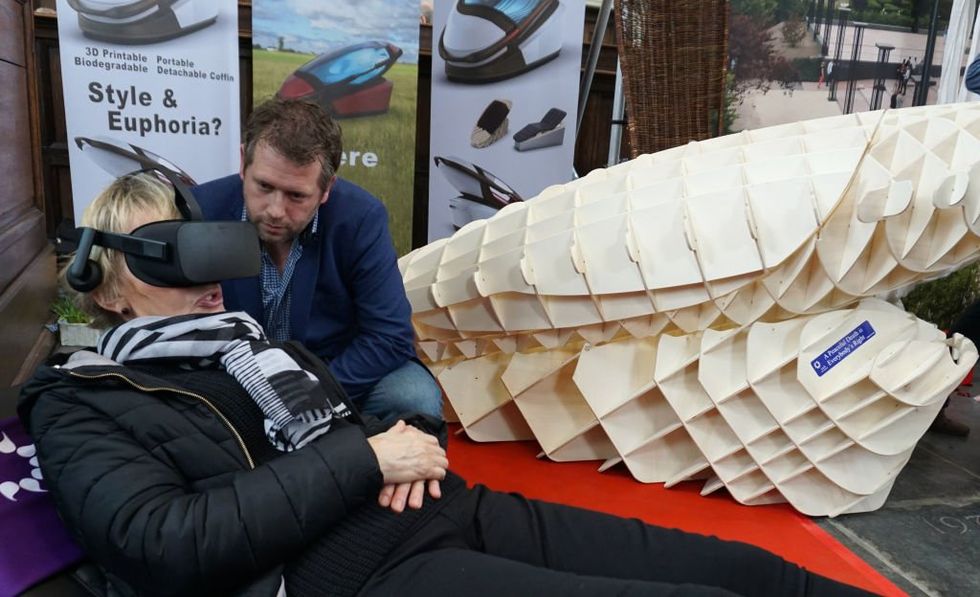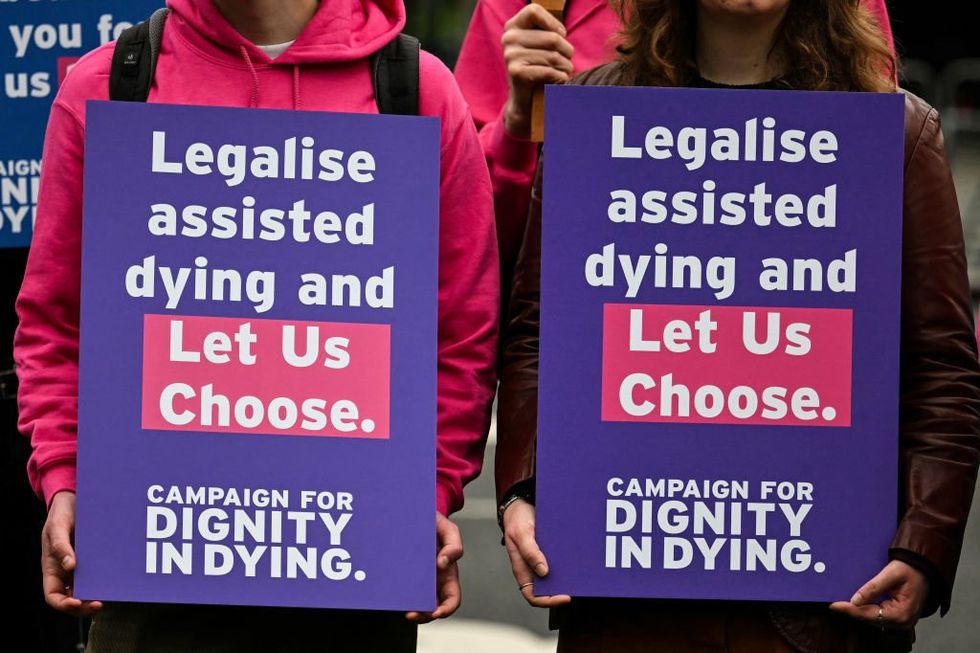Eat the bugs and die in the pods: Swiss assisted death pod sparks outrage
Multiple arrests have been made after a 64-year-old American woman became the first person to use an actual suicide pod in Switzerland. This suicide pod is called the Sarco and has been in development since 2017. At that time, its inventor coined himself the “ Elon Musk of Assisted Suicide.” Dr. Philip Nitschke told Newsweek that he has been drawn to the world of euthanasia since he was a young medical school graduate in Australia, inspired by the work of euthanasia enthusiast Dr. Jack Kevorkian. The Netherlands also became the first government to legalize euthanasia nationally (under strict conditions at the time) in 2002. However, the first country to allow children to kill themselves was Belgium in 2014. Before the Sarco, Nitschke was already hard at work making suicide machine prototypes and successfully killing people with them. His first machine was a laptop hooked up to an intravenous system. The computer would ask a patient if the patient wanted to die and then trigger a lethal injection of barbiturates or depressants. This death machine was used to kill four people in Australia from 1996 to 1997, a brief period when euthanasia was legalized in the country before it was struck down. It was made legal again in 2022. Nitschke, then 70, admitted that his work surrounding how to best help people die has taken some time. "I've spent the last 20 years fighting for the legislation that just passed," he said at the time. He noted he had aided hundreds of "rational suicides" over the years and even published a book in 2006 describing the most painless and efficient ways to commit suicide. All of this spawned the Sarco. JAN HENNOP/AFP via Getty Images What is it? The Sarco was introduced in 2021 when suicide capsules were legalized in Switzerland. With the help of Dutch designer Alexander Bannink, Nitschke managed to get the capsules through a legal review of authorized forms of assisted suicide. The doctor boasted of the freedom of killing oneself without government bureaucracy. "The benefit for the person who uses it is that they don't have to get any permission, they don't need some special doctor to try and get a needle in, and they don't need to get difficult drugs to obtain," Nitschke said, per Business Insider. After their legal victory, the 3D-printed device was touted as a portable option that could be towed wherever the user wanted to die. In 2020, approximately 1,300 people died by assisted suicide in Switzerland. YouTube took down a demonstration of the machine for violating community guidelines; however, it chiefly involved using virtual reality goggles to show users what it would be like to be suffocated by gas in a picturesque setting ... to utilizing its viewing window. “An idyllic outdoor setting or in the premises of an assisted-suicide organization” are the perfect situations, Nitschke said. The user must pass a mental capacity test and be asked several questions before activating the machine. They are then prompted with a button that will bring oxygen levels dangerously low, after which the vessel fills with nitrogen gas until death. As any scientist in his position would state, Nitschke said suicide pod lovers will feel “no panic” and “no choking feeling” but instead become “a little disoriented” and “slightly euphoric.” Who makes it? Designer Bannink of the Sarco doesn’t appear to mention his suicide pod designs on his website or portfolio, opting to display underwater car drawings and flamboyant bikes. He does, however, cite his design philosophy as the following: “Any company can make ‘good’ products! So the way to distinguish yourself as a brand is to do it smarter or more beautiful than others.” The company behind the recent suicide pod usage is a firm called the Last Resort. The company commented on the matter, saying, “On Monday 23 September, at approximately 16.01 CEST, a 64-year old woman from the the mid-west in the USA died using the Sarco device.” Co-president of the organization Florian Willet called the woman's death “peaceful, fast and dignified.” She added that it occurred under “a canopy of trees, at a private forest retreat.” The Last Resort refers to itself as a “new human rights organization” that offers a drug-free means of “elective, peaceful & dignified death.” “A good death is a fundamental human right,” the company says, noting that it offers free services to approved patients. The pod is 3D-printed and costs vary depending on the manufacturer. Exit International, which helped develop the Sarco, estimated costs at around $19,000 per unit. Is it legal? JUSTIN TALLIS/Getty Images The first use of the Sarco came on the same day Swiss Interior Minister Elisabeth Baume-Schneider told the Swiss National Council that she considers the use of the Sarco to be illegal. “The Sarco suicide capsule is not legal in two respects. ... On one hand, it does not fulfill the demands of the product


Multiple arrests have been made after a 64-year-old American woman became the first person to use an actual suicide pod in Switzerland. This suicide pod is called the Sarco and has been in development since 2017. At that time, its inventor coined himself the “ Elon Musk of Assisted Suicide.”
Dr. Philip Nitschke told Newsweek that he has been drawn to the world of euthanasia since he was a young medical school graduate in Australia, inspired by the work of euthanasia enthusiast Dr. Jack Kevorkian.
The Netherlands also became the first government to legalize euthanasia nationally (under strict conditions at the time) in 2002. However, the first country to allow children to kill themselves was Belgium in 2014.
Before the Sarco, Nitschke was already hard at work making suicide machine prototypes and successfully killing people with them. His first machine was a laptop hooked up to an intravenous system. The computer would ask a patient if the patient wanted to die and then trigger a lethal injection of barbiturates or depressants.
This death machine was used to kill four people in Australia from 1996 to 1997, a brief period when euthanasia was legalized in the country before it was struck down. It was made legal again in 2022. Nitschke, then 70, admitted that his work surrounding how to best help people die has taken some time.
"I've spent the last 20 years fighting for the legislation that just passed," he said at the time.
He noted he had aided hundreds of "rational suicides" over the years and even published a book in 2006 describing the most painless and efficient ways to commit suicide.
All of this spawned the Sarco.
 JAN HENNOP/AFP via Getty Images
JAN HENNOP/AFP via Getty Images
What is it?
The Sarco was introduced in 2021 when suicide capsules were legalized in Switzerland. With the help of Dutch designer Alexander Bannink, Nitschke managed to get the capsules through a legal review of authorized forms of assisted suicide. The doctor boasted of the freedom of killing oneself without government bureaucracy.
"The benefit for the person who uses it is that they don't have to get any permission, they don't need some special doctor to try and get a needle in, and they don't need to get difficult drugs to obtain," Nitschke said, per Business Insider.
After their legal victory, the 3D-printed device was touted as a portable option that could be towed wherever the user wanted to die.
In 2020, approximately 1,300 people died by assisted suicide in Switzerland.
YouTube took down a demonstration of the machine for violating community guidelines; however, it chiefly involved using virtual reality goggles to show users what it would be like to be suffocated by gas in a picturesque setting ... to utilizing its viewing window.
“An idyllic outdoor setting or in the premises of an assisted-suicide organization” are the perfect situations, Nitschke said.
The user must pass a mental capacity test and be asked several questions before activating the machine. They are then prompted with a button that will bring oxygen levels dangerously low, after which the vessel fills with nitrogen gas until death.
As any scientist in his position would state, Nitschke said suicide pod lovers will feel “no panic” and “no choking feeling” but instead become “a little disoriented” and “slightly euphoric.”
Who makes it?
Designer Bannink of the Sarco doesn’t appear to mention his suicide pod designs on his website or portfolio, opting to display underwater car drawings and flamboyant bikes.
He does, however, cite his design philosophy as the following:
“Any company can make ‘good’ products! So the way to distinguish yourself as a brand is to do it smarter or more beautiful than others.”
The company behind the recent suicide pod usage is a firm called the Last Resort. The company commented on the matter, saying, “On Monday 23 September, at approximately 16.01 CEST, a 64-year old woman from the the mid-west in the USA died using the Sarco device.”
Co-president of the organization Florian Willet called the woman's death “peaceful, fast and dignified.” She added that it occurred under “a canopy of trees, at a private forest retreat.”
The Last Resort refers to itself as a “new human rights organization” that offers a drug-free means of “elective, peaceful & dignified death.”
“A good death is a fundamental human right,” the company says, noting that it offers free services to approved patients.
The pod is 3D-printed and costs vary depending on the manufacturer.
Exit International, which helped develop the Sarco, estimated costs at around $19,000 per unit.
Is it legal?
 JUSTIN TALLIS/Getty Images
JUSTIN TALLIS/Getty Images
The first use of the Sarco came on the same day Swiss Interior Minister Elisabeth Baume-Schneider told the Swiss National Council that she considers the use of the Sarco to be illegal.
“The Sarco suicide capsule is not legal in two respects. ... On one hand, it does not fulfill the demands of the product safety law, and as such, must not be brought into circulation.”
“On the other hand,” she continued. “The corresponding use of nitrogen is not compatible with the article on purpose in the chemicals law.”
At the same time, the Last Resort cites on its website that Switzerland is actually “one of the few countries” in which helping someone kill themselves “is not a crime. “
The Daily Mail reported however that Swiss law indicates that a person can receive assisted suicide so long as the person takes their life without “external assistance” while those who help the person die cannot do so for any “self-serving motive.”
This is likely why Last Resort offers its program for free.
The Last Resort said its program exists within the law and does not require specific approval due to the fact that the user is the one who presses the button to end their own life. It also cites that the user proves they are of sound mental capacity.
Stateside, euthanasia was first made legal in Oregon in 1997. This was followed by approval in California, Vermont, and Washington, but it is not federally legalized.
Internationally, Australia, Belgium, Canada, Ecuador, Luxembourg, the Netherlands, New Zealand, Portugal, Spain, and of course Switzerland have all legalized assisted suicide.
Russia is the only country in which all forms of euthanasia are illegal, as of November 2011.
In the Netherlands, where the suicide-pod designer is from, assisted suicide eligibility extends to infants as well. If aged 1-12, terminally ill children can be killed by the state. Those who are 5-10 can be killed if they are suffering unbearably or have no hope of improvement.
“The end of life for this group is the only reasonable alternative to the child’s unbearable and hopeless suffering,” the government said in 2023, per the Guardian.
The Netherlands also became the first government to legalize euthanasia nationally (under strict conditions at the time) in 2002. However, the first country to allow children to kill themselves was Belgium in 2014.
Canada, which boasts a robust suicide system, paused its program for those who are mentally ill.
The country’s requirements are rather loose overall, allowing those with PTSD, depression, anxiety, and other survivable illnesses to use the country’s Medical Assistance in Dying program.
Are people using it?
Unfortunately, the trend of euthanasia is becoming more popular in places like Switzerland, where the suicide pods are currently available. In 2020, approximately 1,300 people died by assisted suicide in the country.
The Last Resort reported it had 120 applicants waiting to use its machine to end their lives; about 25% of those people were British. This included a married couple that wanted to be the first to use a double suicide pod.
The Netherlands said that only one person between 12-16 used government suicides in 2022 while it is estimated that the country’s new age rules would apply to about 5-10 children per year.
Sadly, euthanasia became the fifth-highest cause of death in Canada during the summer of 2024. According to a report, it is evidence that medical professionals in Canada “are not viewing MAiD as an option of last resort only."
With ages being lowered and allowable reasons for euthanasia being widened, societies are not far from the suicide booths portrayed in the cartoon “ Futurama,” it seems.
In fact, the only aspect of reality the cartoon appeared to get wrong is that it would actually cost money to be euthanized.
Originally Published at Daily Wire, World Net Daily, or The Blaze
What's Your Reaction?

































































































